Grapevine Stories
Lamanai in Belize - the best 24 hours?
One of our valued partners, Justin Wateridge from Steppes Travel, gives us a wonderful insight about his 24 hours at the ancient Mayan ruins in Belize.
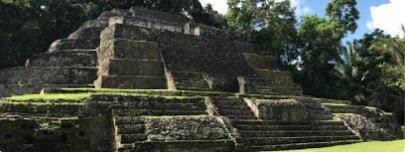
“Under six foot is cute. Over six foot is not cute,” said my guide, Ruben, with understated Belizean charm. Ruben was referring to the capture, survey and release that we would be taking part in that evening as part of research into Morelet’s crocodile. We were in Lamanai in north-western Belize.
Twenty-four hours earlier we had arrived, slaloming along twenty miles of the New River.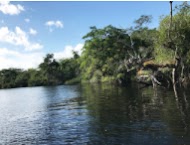 Vegetation was fecund and rich, trees crowding the water’s edge, drinking thirstily from the river. The vibrant green of the leaves reflected in the tannin-rich waters of the river. The sun was bright. The wind was in our hair. We sped along.
Vegetation was fecund and rich, trees crowding the water’s edge, drinking thirstily from the river. The vibrant green of the leaves reflected in the tannin-rich waters of the river. The sun was bright. The wind was in our hair. We sped along.
Later that evening, we head across the New River lagoon in a speedboat embarking on a night safari. Immediately, Ruben shouts, “Bamboo chicken.” He spotlights two iguanas in the tree. One green and the other orange, female and male respectively. “Both sexes are green when young and then about two, the male changes colour. They sleep at the end of the branch to avoid pythons. When they feel vibrations, they jump into the water and swim away.”
In quick succession, Ruben points out a barn owl, night jar, a green kingfisher, green heron, a tricoloured heron, a blue heron and a limkin.
“How do you see that?”
“Eyeshine. Nocturnal vertebrates have a layer of tissue in their eye that reflects light. So, you can see most animals except snakes and tarantula.”
Ruben makes it sound so easy as he points out the eyes of a large crocodile before it dives to deeper water. He spotlights a fishing bat scooping a fish from the water. “Can you see that?” I strain my eyes. “False vampire bat. It has a two-metre wingspan and feeds on parakeets and possums. There are over forty bats in this region.”
“A great blue heron. A North American migrant, it stands on one leg to save heat energy.” He skilfully navigates the boat to within three metres of a ringed kingfisher. Its twenty-centimetre size seemingly amplified in the dark.
“What did you see?” 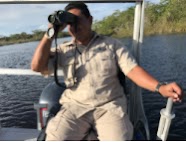
“Oh, it was nothing.”
“Then you didn’t see the six bats hanging under the tree?”
Hugging the underside of the branch were six proboscis bats so tiny and so beautifully camouflaged that whilst only a couple of feet away, I did not see them at first.
“A provision tree flower. It only flowers for one night of the year.” Any deficit of frequency is more than made up for the brilliance of the flower. Its narrow petals open like a banana peel to reveal hair-like brightly coloured stamens.
The miracle of nature continues the next morning as we enjoy the great beauty of the dawn. Everything is still but not quiet. A banana silk spider sits at the centre of its glistening web. The red, white and brown of an owl eye butterfly warming itself in the sun’s first rays.
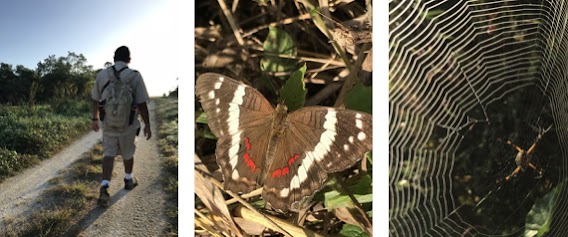
Feet sodden with dew as we walk, morning begins and bursts into movement. The jumping of the blue black grassquit, locally known as ‘Johnny Jump Up’. A small trail of leaf-cutter ants a busy ferrying their precious cargo. The call of the yellow-billed cacique. The loud and melodious voice of the diminutive spot breasted wren. The throaty roar of the howler monkeys, clinging to the treetops with their prehensile tails. They howl in both the early morning and again at dusk to announce where they are so other troops shay away.
Ruben points out the flora. A kapok tree whose cotton was harvested by the Mayans. The cohune palm, whose oil was used by the Mayans not just for cooking but also glazing pottery.
“See these little trails? Don’t stand on them too long – it’s a fire ant trail. When they bite, they hurt.”
After a hearty breakfast, we visit the Mayan site of Lamanai. An olive-throated parakeet screeches overhead. Lamanai means submerged crocodile. The modern-day bastardised pronunciation means drowned insect.
Lamanai is located on the west bank of the New River lagoon 40 kilometres west of Altun Ha and 48 kilometres northeast of San Jose. The New River provided important riverine trade. Whatever the rationale of the founders, Lamanai flourished for almost three millennia far exceeding the average lifespan of most Mayan communities. A presence at Lamanai was established in around 1,000 BC. Lamanai is distinguished by a vibrant Post-Classic ceramic trend.
It is impossible to determine the exact size of the population but archaeologists estimate there to have been about one million in what today is Belize. The population today is 360,000. During the Classic period, Lamanai had a population 40 – 60,000.
There are a number of inter-related factors as to why the Mayans were able to develop such an advanced civilisation. Ecological adaption, temporal and spatial diversity, unity of elite subculture, trade and interaction, competition and ideology. As to their political organisation, this is not well understood, although it is generally agreed that the cities were largely autonomous and functioned as city states.
A white-nosed coati nonchalantly crosses the path in front of us oblivious to our presence. Its tail erect and high, a camouflage mechanism – it is the primary food source of many cats. It begins scratching and snuffling for tarantula. Not to be outdone, Ruben picks up a thin twig and twiddles into a hole in the ground at the base of a tree. Seconds later a Mexican red rump tarantula emerges inquisitively. Without hesitation, Ruben scoops her up and places her in my hands. She is beautiful if not a little too clingy – her legs feel needle-like as they clasp to my arm. The tarantula does not have the friendliest of reputations – their threatening fangs and the itchy hairs they fire at enemies might have something to do with this – but she was very relaxed. Easy to see why she can live up to twenty years old.
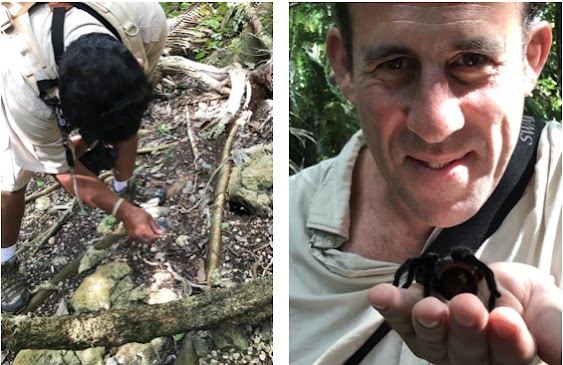
In 1974 -86, excavations were led by David Prendergast and his one hundred stung team. They only worked on 5% of the total estimated site. However, what they unearthed is impressive. The Mask Temple, so called due to the huge stone masks that adorn either side of the worn and moss-covered staircase, dates from 110BC – AD 450.
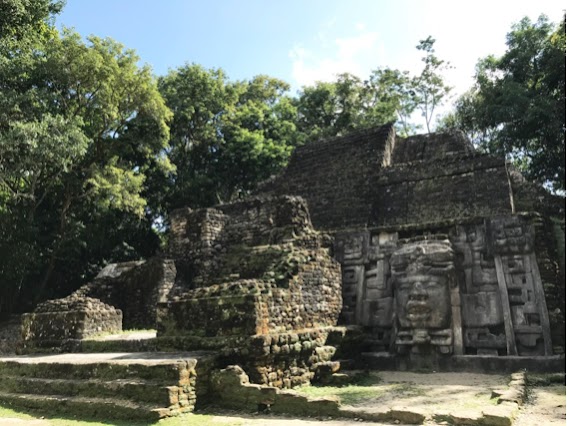
“Why is it hollow?”
“For acoustic effect,” replies Ruben clapping his hands to illustrate the acoustics and how they amplify the noise with the bouncing of sound.
We move to the High Temple, a black headed trogon calling from the surrounding trees. Built in 100 BC and standing 33 metres high, it is one of the oldest tallest Mayan structures. All Mayan structures that are taller – such as Tikal in Guatemala – were built around 600 AD.
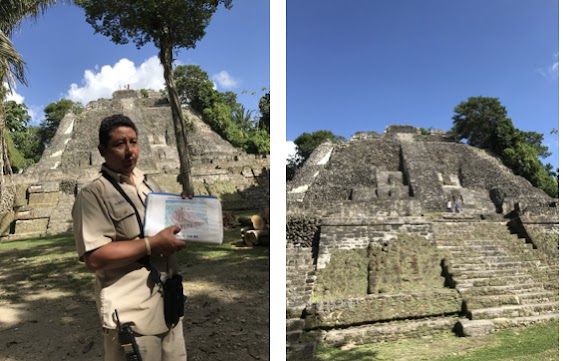
“Why did the Mayans build the temples so high?”
“To impress. They were sacred and not for climbing – only accessed by the elite rulers and priests. The steepness was to convey a sense of dignity when climbing.”
Sweat pouring off me, any modicum of dignity was long gone but the discomfort was well worth it for the stunning views over the jungle from the top.
The Jaguar temple, so called because of the faces of two jaguars at the base of the temple, was built in 600 AD. Last remodified in 1300 AD, it is the last in the Mayan world. Elsewhere in the world of the Maya, construction stopped in 950 AD. Lamanai was one of the earliest and also longest lasting sites, falling into disrepair at some point in the fifteenth century.
I nearly met a similar fate at the hands of Lamanai’s colourful and entertaining barman, Raul. Nineteen years of service means a lot of ticks and much laughter.
“How many vodkas are you allowed before you play with crocodiles?”
“That depends on how big you want to see them?”
With trepidation we board our air boat – the vessel best suited to surfing the marsh of Lamanai. We are handed ear muffs and in our cocooned world we head off across the lagoon. Everything is black. The inky darkness of the night sky sprinkled with a bright array of stars. We speed over the horsetail grass at exhilarating speed, like skiing over grass. The spotlight searches side to side. At one point I took my ear defenders off and was bombarded by the thunderous roar of the engine.
The boat turns sharply. The engine is cut. Silence. Apart from the chirping of leopard frogs. Ruben has spotted a crocodile at the edge of a deep pool. He scans. We wait expectantly.
“It has dived down.”
“How long can crocodiles spend underwater?”
“Up to two hours.” The engine booms back into deafening action and we move on.
We speed through the night, the light scanning back and forth in the seemingly futile search for crocodiles. Minute after minute Metaphors were springing to mind, when suddenly the boat roared to a stop. Within seconds, Ruben had a noose around the neck of a young crocodile who hissed and wriggled. For a couple of minutes, the croc splashed and thrashed as it twisted and turned.
“He is now completing a death roll. I am trying to tire him – given that they are coldblooded, he will soon stop and thus be easier to handle”
The aggressive hiss soon succumbed to a plaintive squeak, so by the time Ruben landed the crocodile he was wonderfully placid. He was also so exquisitely soft. Easy to see why –although difficult to understand why – crocodile leather is a luxury item. It had no smell.

To prevent fawning further over the young croc, Ruben starts explaining some of the crocodile’s characteristics.
“You see here, if I press on his yes then pop down. This allows him to go under trees.”
“Sense is in the nose.”
“Ear is behind its eye.”
“Feel the pits on his bottom jaw. This is how it senses vibration.” And is one of the reasons why an airboat is used.
“How old is it?”
“If I told you, I would be lying.”
“Would it hurt if it bit me?”
“Our bite is about 150 pounds per square inch. This crocodile’s bite would be about 3,000 pounds per square inch. It would crush your hand.”
Questions over, time for the research and data element. Measurements are dutifully taken and recorded. The exact coordinates, the location was marsh, the depth of the water was 51 centimetres, the capture time was 20:30, the temperature of the water 27C. Weight 2.6 kg, length from snout to tail 102.5 cm, length of the head 15.2 cm, girth of the tail 18.3 cm – a guide to the health of the crocodile in that if it is meaty it is in good health. Then finally a microchip is inserted in its tail and he is released back into the water.
“How many have you caught?”
“I don’t know. I started catching crocodile in 1994.”
“Can we catch one more?”
Grapevine is a trusted network of private members, linking kindred spirits from town or country. Members promote, sell or buy goods and services within the network.
Grapevine also believes in supporting young people to get a strong start through internships and work placements. We also help a number of charities including Heads Together and The Injured Jockeys Fund.